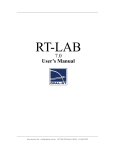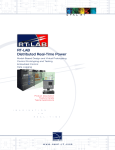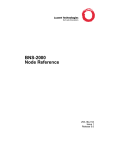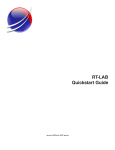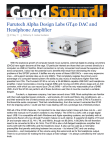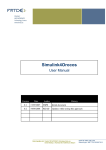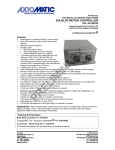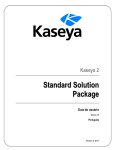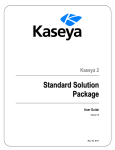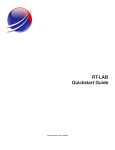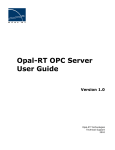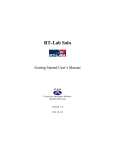Download Laboratory set-up for Real-Time study of Electric Drives - Opal-RT
Transcript
Session T3H Laboratory set-up for Real-Time study of Electric Drives with Integrated Interfaces for Test and Measurement Fong Mak, Ram Sundaram, Varun Santhaseelan, and Sunil Tandle Gannon University, [email protected], [email protected], [email protected], [email protected] Abstract-This paper presents a real-time instrumentation setup for laboratory experiments in the course on electric drives that is adapted to incorporate the integrated response and analysis interfaces developed in the course on test and measurement. The experimental setup is modeled after the one proposed by the University of Minnesota. However, the setup along with the modification to the model with the electric drives assembly as hardware-in-the-loop (HIL) is first correctly executed under the RT-LAB real-time system solution. The paper focuses on the design and validation of the electric drives experiments with RT-LAB solution and the LabVIEW API capability provided by RT-LAB that allows user-designed virtual instrumentation-based human-machine interfaces. With this setup, students are not only able to use the same laboratory platform for electric drives studies in the electric drives class, but are also able to study LabVIEW design as part of the Test and Measurement class. The intention is to further develop this setup as a central laboratory platform for use in other courses such as electronics system design, and control. However, for this paper, the focus is on the illustration of how this setup can benefit the subject matter in two courses: electric drives and test and measurement. Index Terms - Electric drives, Hardware-in-the-loop, LabVIEW, Test and measurement INTRODUCTION This paper presents a real-time instrumentation setup that benefits the subject matter in two courses: electric drives and test and measurement. The paper discusses virtual instrumentation-based interfaces for real-time control and display of electric machine drives. This approach will lead to the flexibility of applying this setup as a platform to study electric drives as well as the LabVIEW-based (from National Instruments, Inc.) experimentation design. In this lab, the machine drive is implemented using a distributed real-time simulation system from Opal-RT [1] with machines and power electronics drive board as hardware-in-the-loop (HIL). The simulation executes on a hardware configuration consisting of the Command Station (host PC) communicating with the target node (another PC) via Ethernet communication links, I/O boards interfaced to HIL. The Command Station serves as the user interface to edit and modify models, to view model data, to execute the model, to convert the model into C code and compile the code in the target node, and load the code onto each target node. The target nodes perform real-time execution of the model simulation and include a real-time communication interface between the nodes and I/O modules. The models are designed and implemented in Simulink (from The Mathworks Inc.). For instance, the experiment to perform a closed-loop control of a dc motor consists of the following HIL setup: a dc motor under test coupled with a DC motor as load, and a power-electronics drive board interfaced to the dc motor under test. For the experiment, students are to design and implement a closed-loop speed control of a DC motor drive. The steps may involve (a) creating a Simulink model for the dc motor, (b) designing and testing the controller on the simulation model of the DC motor, (c) replacing the DC motor model with the real motor, (d) implementing the tuned controllers in real-time on the target node, and (e) building the LabVIEW interface with controls for variables such as the reference speed of the motor (rpm), the reference frequency (Hz), numerical indicators to display the frequency of the induction motor, the speed of the DC motor, and graphs for phase voltage and phase current waveforms. The experimental setup is modeled after the one proposed by the University of Minnesota [2], [3]. However, the setup along with the modification to the model with the dc motor assembly in the loop (HIL) is first correctly executed under the RT-LAB real-time system solution. This paper will (a) give a description of a real-time controlled machine drive experiment; (b) explain the design of the LabVIEW interface for test and measurement which serves to enhance the flexibility and capability to provide measurement analysis and control with visual interfaces. Not only does this LabVIEW application enhance the functionality of this experiment, but it also provides a platform of implementation and testing for the students studying LabVIEW design as part of the Test and Measurement class. The paper consists of five sections. Section 2 provides a brief description of a real-time controlled dc machine drive experiment as an illustration. Section 3 presents the LabVIEW-based virtual instrumentation (VI) interface to this experiment. In this section, response and analysis interfaces 978-1-4244-1970-8/08/$25.00 ©2008 IEEE October 22 – 25, 2008, Saratoga Springs, NY 38th ASEE/IEEE Frontiers in Education Conference T3H-1 Session T3H for the electric drives experiment are presented. Section 4 outlines the conclusions and future considerations. Section 5 lists the references. SECTION 2: HIL EXPERIMENTAL SETUP Figure 1 displays the configuration of a typical dc drive system as an illustration. The machine drive [1] shown in Figure 1 is implemented originally using a distributed realtime simulation system from Opal-RT with electric machines and power electronics drive board as hardware-in-the-loop (HIL). The control algorithm for the dc drive system and its associated monitoring graphical user interface (software model) are modeled in Simulink and resides in the Opal-RT simulation system. The software model simulation executing on the Command Station (host PC) communicates with the target node (another PC) via Ethernet communication links, and I/O boards interfaced to HIL. The Command Station serves also as the user interface to edit and modify models, to view model data, to execute the model, to convert the model into C code and compile the code on target node, and load the code onto the target node. The target node performs real-time execution of the model simulation and includes a real-time communication interface between the node and I/O modules. The simulation model for the dc drive system under study consists of a closed-loop control algorithm and the user interface for controlling inputs and monitoring selected signals as the outputs. The Opal-RT simulation system requires two subsystem blocks. The main computational elements of the model are always contained in the master subsystem that starts with “SM_”. The console subsystem is the subsystem operating on the command station that enables the user to interact with the system. It contains all the Simulink blocks related to acquiring and displaying data. In RT-LAB, OpComm blocks are used to enable and save communication setup information. All inputs to top-level subsystems must first go through an OpComm block before they can be used. The two subsystems are shown in Figure 2. The details of the master subsystem, SM_Controller, are shown in Figure 3. The master subsystem consists of the following blocks: (a) a speed controller and a current controller (b) a PWM generator (c) Analog In model that captures voltage and current (d) a Speed measurement block to capture speed readings The speed-control model receives the input signal, Speed_ref, from the Console subsystem, SC_Console. This signal is a slider gain (shown in Figure 4) and is used to alter the duty cycle of the PWM pulses that are applied to the Power Electronics Drive Board via the multi-function OP5110-5120 digital I/O board for speed control of the DC motor. This board has the capability to generate two independent PWM voltage sources (A1B1C1 and A2B2C2) from a constant DC voltage source. Hence two machines can be independently controlled for independent control variables, at the same time. However, for this experiment, only phase A1 and B1 of one PWM voltage source is used as in the H-bridge format for the dc motor control. FIGURE 1 REAL-TIME CONTROLLED DC-DRIVE SYSTEM FIGURE 2 SUBSYSTEMS OF THE MOTOR MODEL The speed measurement model, on the other hand, provides information on the speed, frequency, position, and direction of rotation of the motor. This model makes use of the event detector feature in the OP5110-5120 and the RealTime Events (RTE) library block from Opal-RT to generate signals into states and times before converting into digital waveform. The motor current, dc-voltage etc. from the Power Electronics Drive Board are fed through analog-todigital module before going into the OP5110-5120. The output of the speed controller is ia_ref that feeds into the current-controller block. The current-controller gives the necessary control voltage signal to the PWM generator. The PWM generator in turn generates the PWM signals needed to drive the power-electronics board as shown in Figure 3. The Console subsystem, shown in Figure 4, is used as the human-machine interface (HMI). A slider is used as the desired set point for speed reference which is fed back as input to the master subsystem. The signals to be monitored, 978-1-4244-1970-8/08/$25.00 ©2008 IEEE October 22 – 25, 2008, Saratoga Springs, NY 38th ASEE/IEEE Frontiers in Education Conference T3H-2 Session T3H such as speed, current, and voltage are connected to the display scope as in indicated in Figure 4. Figures 5 and 6 show typical displays on the console indicators. control experiment, the drive setup will naturally be given as default where the control design principle can be exercised and validated. It is one of the goals to have this HIL experiment setup to be used as the central platform for other subject matters such as control, power electronics, FPGA design, etc. to be taught. Once the controller is designed and validated on the host PC, the DC motor model is removed and the controller is put in the form as shown in Figure 3 for HIL simulation and validation. Figure 5 shows the results collected in realtime and can be superimposed with the simulation results obtained by Simulink to verify and validate the controller design as well. SC_Console FIGURE 4 CONSOLE SUBSYSTEM FIGURE 3 MASTER SUBSYSTEM NON REAL-TIME EXPERIMENT SETUP Non real-time experiment basically is the work required on the host PC for controller design or any other validation work needed before implementing the controller on the target node for HIL simulation. For this particular FIGURE 5 experiment, students are to design controller first on a SPEED STEP CHANGE FROM 200 RAD/S TO 400 RAD/S simulation model of the DC motor using Simulink. Students are to design both the inner-loop current controller and the outer-loop speed controller. The two control loops are PI type of controllers. The design process is given and the DC motor’s dynamic equations are given and derived from the previous experiment. Figure 7 shows the cascade control of DC motor at system level in Simulink. The details of this particular experiment are available in [6]. Since the intention of the drive lab is to focus on the understanding of various aspects of drive components including its control, FIGURE 6 the controller design is part of the work, but emphasized THE CORRESPONDING CURRENT RESPONSE only for a basic PI controller design. If this were to be a 978-1-4244-1970-8/08/$25.00 ©2008 IEEE October 22 – 25, 2008, Saratoga Springs, NY 38th ASEE/IEEE Frontiers in Education Conference T3H-3 Session T3H FIGURE 7 SIMULINK MODEL FOR CASCADE CONTROLLER As far as drive experiments are concerned, the inherited Opal-RT HMI is sufficient for editing, loading, monitoring, and data collection. Table 1 gives a list of experiments that pertains to drive studies. This list of experiments is a complete make over from those of [1] that have been structured to work with Opal-RT system. They are available at [6]. TABLE 1 ELECTRIC DRIVES EXPERIMENTS Experiment 1 2 3 4 5 6 7 8 Topic Introduction to the FPGA-based electric drives system Simulation and real-time implementation of a switch-mode DC converter No-load DC motor test Characterization of DC motor DC motor speed control Four-quadrant operation of DC motor Characterization of induction motor V/F speed-control of a three-phase induction motor SECTION 3: THE LABVIEW INTERFACE As an alternative to the inherited Opal-RT HMI, the LabVIEW interface is developed. The intention is to allow students to study LabVIEW design as part of the Test and Measurement class using electric drives setup as a platform. The LabVIEW interface for this experiment is displayed in Figure 8. This is a real-time interface with a single panel comprising (a) controls for motor input variables such as the reference speed, (b) numerical and graphical indicators to display the speed of the DC motor, and (c) graphs for the current and voltage waveform. The advantages of the LabVIEW-based HMI are identified as follows: enrolled in the Advanced Instrumentation & Measurement course. The students were assigned to work in teams comprising 2 to 3 members. The students were given a working Simulink model of the DC motor drive. This model consisted of the Master and Console subsystems as shown in Figure 3 and Figure 4, respectively. First, the students ensured that the model executed under RT-Lab control. To do so they had to compile the model, assign the model to a target, load the model, and execute the model. If this was successful, they reset the model in RT-Lab. In this experiment, the students had to build the LabVIEW GUI [4], [5] shown in Figure 9 and execute the DC motor model using their LabVIEW GUI. A template of the LabVIEW GUI was provided to the students. LABVIEW MODEL: FRONT PANEL The front panel of this LabVIEW GUI consisted of the following tabs. (a) (b) (c) (d) Model Configuration Model Manager Model Controls - response interface Model Analysis - analysis interface The steps to build and execute the model using this GUI are described as follows: Model Configuration: To load and connect to the model, first specify the path to the model. The model is executed under the mode “Hardware synchronized”. The target platform operates in Windows NT and the embedded node is QNX195. The model is executed on startup and reset before it is quit. Model Manager: In LabVIEW, the three choices to manage the model are (1) Execute (2) Pause (3) Restart. For example, the model state is “Running” when the model is executing. Model Controls- response interface: This portion of the front panel contains the user-defined control signals and model time responses or indicators. The control signals such as the desired direction of rotation are sent to the model while the model responses such as speed, voltage and current (functions of time) are received from the (a) organized record of control inputs, model. Figure 8 displays the front panel of the response (b) systematic tracking of motor responses, interface. (c) clear presentation of the evidence of the experiment, In order to integrate RT-Lab with LabVIEW, certain and subVI’s may be used to interact with the RT-Lab API. This is (d) advanced measurement analysis (e.g. Fourier spectra, illustrated in one of the LabVIEW block diagrams in Figure THD) 9. To send signals to the model, first find the sequence titled Send data to target in the Acquisition section of the block diagram of the LabVIEW GUI. Provide the signals to a Build TYPICAL LABVIEW EXPERIMENT SETUP Array node. Then, the wire coming out from this node is sent to the SM_Controller subsystem through a subVI called The laboratory experiment titled ‘Design LabVIEW APIs for OpalSetSignal2.vi. If one must send more signals to the RT system models with HIL’ was performed by students model, increase the number of inputs in the Build Array 978-1-4244-1970-8/08/$25.00 ©2008 IEEE October 22 – 25, 2008, Saratoga Springs, NY 38th ASEE/IEEE Frontiers in Education Conference T3H-4 Session T3H node. The signals connected to the Build Array must be in the same order as they are connected to the OpComm block. Similarly, if a vector is connected to the OpComm block, the order must be the same as they are in the vector. To send the desired signal to the appropriate indicator, use an Index Array and specify the index which corresponds to the position of the signal in the OpComm of the SC_Console subsystem. Then wire the output of the Index Array to the terminal of the indicator chosen. Note that both OpalSetSignal2.vi and OpalGetAcqGroupSignals2.vi are subVIs provided by Opal-RT as part of their API capability to allow interface to other custom built interface. Model Analysis- analysis interface: This portion of the front panel contains the outcomes of any time-based or frequency-based measurement analysis performed on the signals. For instance, Figure 10 consists of the display of the result of averaging done on the speed readings as well as the result of the filtering done on the current waveform. FIGURE 8 LABVIEW-BASED RT INTERFACE FIGURE 10 ANALYSIS INTERFACE Additional analysis tools include analysis in the frequency domain, total harmonic distortion (THD) measurements for the specified motor response signals. The steps to develop the analysis interface are as follows: FIGURE 9 BLOCK DIAGRAM FOR LABVIEW MODEL 1. Identify the signals received from the motor model on which measurement analysis must be performed. The acquisition of these signals has been discussed as part of To receive signals from the model, find the sequence the Model Controls - response interface. titled Receive data from target in the Acquisition section of the block diagram. Then use the subVI called 2. Implement the process of signal analysis using the function palette provided by LabVIEW. This palette OpalGetAcqGroupSignals2.vi. Provide the number of includes virtual instruments for time-frequency analysis signals that must be received in that group and the and data filtering. acquisition group one wishes to receive the data from. 3. Create the tab on the overall front panel of the interface for the display of the outcomes of the analysis. Provide an appropriate label for this tab. 978-1-4244-1970-8/08/$25.00 ©2008 IEEE October 22 – 25, 2008, Saratoga Springs, NY 38th ASEE/IEEE Frontiers in Education Conference T3H-5 Session T3H At present, the students in the course on test and measurement build only the response interface. The students in each team had to properly identify and wire the signals sent to the model (control inputs) as well as signals received from the model (motor responses) as described above. Thereafter, the DC Motor model was executed using their LabVIEW GUI. The students had to observe and record the motor variables for different settings of the real-time control inputs. In future, the lab exercises in this course will include both interfaces. SECTION 4: CONCLUSIONS AND FUTURE WORK The integration of the LabVIEW-based virtual instrumentation with real-time control and display of electric machine drives was successful. The LabVIEW interface improves the laboratory experience for students in both courses. Students in the electric drives course can monitor and analyze the signals with more precision while those in the instrumentation & measurement course can build and customize the HMI for specific applications. In addition, the LabVIEW-based interface promotes cross-course interaction without either group required to have the knowledge of the other group. For instance, the detail of the DC motor experiment (motor equations, field analysis) is not required in the design of the interface by the students of the instrumentation course. Likewise, the execution of the DC motor experiment with a well designed custom HMI does not require knowledge of advanced LabVIEW concepts. The details of the experimental setup for both the electric drives [6] and the LabVIEW interface [7] are provided at the web site. The students in the instrumentation & measurement course can employ LabVIEW to design and build the integrated interface (the response interface and the analysis interface) for the real-time study of electric drives. For the analysis interface, the appropriate function blocks are provided by LabVIEW. An alternate approach to perform the real-time study of drives is to include the desired SIMULINK blocks from MATLAB (e.g. FFT, filters) in the original drive model prior to the creation of the LabVIEW interface for the signals. The introduction of real-time system control and data acquisition in the Advanced Instrumentation & Measurement course is the logical first step to train the students to become effective design engineers in the workforce. However, the following issues must be addressed for continuous growth and improvement. (a) include some theory sessions to reinforce RT concepts and support the lab activity (b) develop additional LabVIEW exercises with RT-HIL control & analysis (c) emphasize the use of LabVIEW tools for RT-HMI design (d) incorporate in-class lab demonstrations and student presentations (e) promote goal-oriented collaborative learning by encouraging the students in the instrumentation class to interact with the students in the electric drives class (f) extend the coverage of the course or offer follow up courses to include advanced RT data analysis and interpretation SECTION 5: REFERENCES [1] “Distributed Real-Time Power System,” Opal-RT manuals, 2007. http://www.opal-rt.com. [2] Mohan, Ned, “DSP Based Electric Drives Laboratory – User Manual,” Department of Electrical and Computer Engineering, University of Minnesota, July 2007. [3] Mohan, Ned, “Electric Drives – An Integrative Approach,” MNPERE, 2003. [4] Ertugrul, Nesimi, “LabVIEW for Electric Circuits, Machines, Drives, and Laboratories,” Prentice Hall, 2002. [5] Travis, Jeffrey and Kring, Jim, “LabVIEW for Everyone,” Third Edition, Prentice Hall, 2007. [6] Mak, Fong, “OpalRT-based Real-Time Controlled Electric Drives Laboratory – User Manual,” Department of Electrical and Computer Engineering, Gannon University, December 2007. http://ece.gannon.edu/labs. [7] Sundaram, Ram, “LabVIEW-based Virtual Instrumentation with RealTime Control Experiments,” Department of Electrical and Computer Engineering, Gannon University, December 2007. http://ece.gannon.edu/labs. AUTHOR INFORMATION Fong Mak, Associate Professor & Chair, ECE Dept., Gannon University, [email protected] Ram Sundaram, Associate Professor, ECE Dept., Gannon University, [email protected]. Varun Santhaseelan, Graduate student, ECE Dept., Gannon University, [email protected] Sunil Tandle, Graduate student, ECE Dept., Gannon University,[email protected] 978-1-4244-1970-8/08/$25.00 ©2008 IEEE October 22 – 25, 2008, Saratoga Springs, NY 38th ASEE/IEEE Frontiers in Education Conference T3H-6








